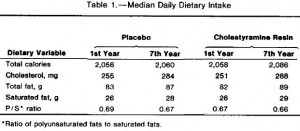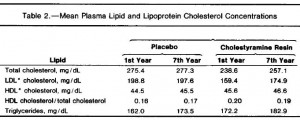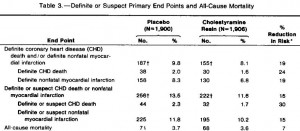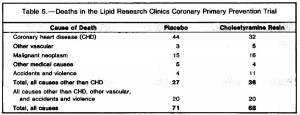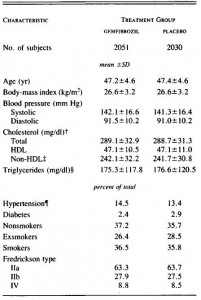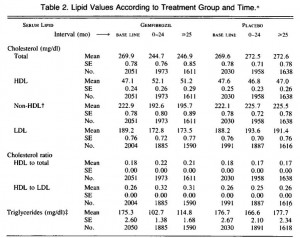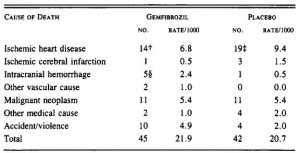“what to do with your cholesterol” or “it may not be a good idea to artificially manipulate your cholesterol levels (pharmaceutically or otherwise)”
Exhibit A: diet study, circa 1962.
A controlled clinical trial of a diet high in unsaturated fat – preliminary observations (Dayton et al., 1962 NEJM)
directly from the manuscript [sic]: “The control diet was a conventional food pattern containing 40 per cent fat calories, mostly of animal origin. The design of the experimental diet involved substitution of vegetable oils for about two thirds of the animal fat, total fat content being kept about 40 percent. An attempt was made to stabilize the iodine value of the control diet at 55 and that of the experimental diet at 100. Multiple vegetable oils were used, the choice depending more on pragmatic than on theoretical considerations. In order of decreasing quantity, corn, soybean, safflower and cottonseed oils were employed.”
basically, the experimental diet exchanged animal fat for vegetable fat (corn & soybean oil). Iodine value reflects dietary fat unsaturation… vegetable fat has a higher iodine value because it has more unsaturated fats
A controlled clinical trial of a diet high in unsaturated fat in preventing complications of atherosclerosis (Dayton et al., 1969 Circulation)
[sic] “The control diet was similar to the regular institutional diet, which is a standard American diet. It provided, by analysis, 40.1% of calories as fat, having a mean iodine value of 53.5; cholesterol intake was 262 mg/1,000 calories (653 mg/day). The experimental diet provided 38.9% of calories as fat, with an iodine value of 102.4, and had a cholesterol content of 146 mg/1,000 calories (365 mg/day). Linoleic acid content of the two diets was 10% and 38% of total fatty acid, respectively.”
Clearly, the experimental diet successfully lowered serum cholesterol… Total mortality was not significantly different, but: “Deaths due to nonatherosclerotic causes numbered 71 in the control group and 85 in the experimental group.” keep those numbers in mind.
Exhibit B: an early cholesterol drug study, circa 1984
not for the faint-hearted.
The Lipid Research Clinics Coronary Primary Prevention Trial (LRCC) is one of the first and biggest trials of a cholesterol lowering drug (cholestyramine) and mortality. They collected a ton of data for both the placebo and treatment group, much of which is quite interesting. The Lipid Research Clinics Coronary Primary Prevention Trial results. I. Reduction in incidence of coronary heart disease. (1984 JAMA)
It was a randomized, double-blind, placebo-controlled primary prevention trial of cholestyramine (24 g/d), lasting 7.4 years. Roughly 3,800 healthy men aged 35-49 with LDL levels greater than 190 mg/dL. This drug is used to treat high blood cholesterol. P.S. this study was done on people who were initially perfectly healthy (“primary prevention” trial).
Divide and conquer
The placebo group: cholesterol intake increased from 255 to 284 mg/d. But their plasma cholesterol decreased from 198.8 to 197.6 mg/dL. LDL decreased from 198.8 to 197.6 mg/dL AND their HDL increased from 44.5 to 45.5 mg/dL.
CHD mortality was reduced by 30% in the cholestyramine group but all-cause mortality only decreased by 7%. Therefore some of the lives saved from CHD were lost to something else. What else?
11 deaths from accidents and violence in the treatment group compared to 4 in placebo. 5 people were killed via homicide or suicide, compared to 2 in placebo. 6 people treated by cholestyramine died in car crashes compared to 2 in placebo. Of all the people who died from accidents, half had high cholesterol. That means that of the 8 people who died from car crashes, 4 had high cholesterol. 3 people on cholestyramine and 1 control died with high cholesterol of accidents. 4 people on cholestyramine killed themselves compared to 2 on placebo.
Did cholestyramine cause a 7% reduction in all-cause mortality because it lowered serum cholesterol levels? Of the 8 people who died, 3 people on cholestyramine were drunk compared to 1 on placebo.
an alternative yet equally equivocal interpretation: when treated with cholestyramine, patients are twice as likely to kill themselves and 3 times as likely to die by drunk driving.
dramatic pause
Exhibit C: fibrates on trial, circa 1987
Helsinki Heart Study: primary-prevention trial with gemfibrozil in middle-aged men with dyslipidemia. Safety of treatment, changes in risk factors, and incidence of coronary heart disease. (Frick et al., 1987 NEJM)
Randomized, double-blind, placebo-controlled primary prevention trial of gemfibrozil (600 mg BID), lasting 5 years. Roughly 2,000 healthy men aged 40 – 55 with cholesterol levels greater than 200 mg/dL. This drug is used to treat high cholesterol and lipids. P.S. this study was done on people who were initially perfectly healthy.
Here’s what gemfibrozil does to blood lipids:
Wham! LDL and triacylglycerols go way down and HDL sky rockets.
Indeed, gemfibrozil does to which it is supposed. … with some minor side effects: cancer rate: 15.1 in the treated group compared to 12.8 in placebo… 10% lower LDL and 18% more cancer. Overall, gemfibrozil was associated with a 6% increase in mortality:
Patients taking gemfibrozil were 2.5 times more likely to die of accidents or violence. That is strikingly similar to what was caused by a 20% reduction in LDL during cholestyramine treatment in the LRCC (above) and the 20% reduction in overall cholesterol levels when animal fat was exchanged with vegetable fat.
Exhibit D, et cetera:
The Pfizer drug Torcetrapib nearly doubles HDL but increased total mortality by 60%.
Addition of nicotinic acid to a statin raises HDL but also increased total mortality (trial halted by Abbott Labs).
Most of these studies were on “healthy” subjects. Maybe high LDL is bad. … Maybe low HDL is bad. …
don’t fuck with your cholesterol levels.

